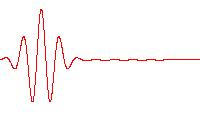Mathematics
P(H1|y) > P(H2|y) / MAP testing
In the case of making a decision between two hypotheses, H1, absent, and H2, present, in the event of a particular observation, y, a classical approach is to choose H1 when p(H1|y) > p(H2|y) and H2 in the reverse case. [14] In the event that the two a posteriori probabilities are equal, one might choose to default to a single choice (either always choose H1 or always choose H2), or might randomly select either H1 or H2. The a priori probabilities of H1 and H2 can guide this choice, e.g. by always choosing the hypothesis with the higher a priori probability.
When taking this approach, usually what one knows are the conditional probabilities, p(y|H1) and p(y|H2), and the a priori probabilities and . In this case,
,
where p(y) is the total probability of event y,
.
H2 is chosen in case
and H1 otherwise.
Often, the ratio is called and is called , the likelihood ratio .
Using this terminology, H2 is chosen in case . This is called MAP testing, where MAP stands for "maximum a posteriori").
Taking this approach minimizes the expected number of errors one will make.
Bayes criterion
In some cases, it is far more important to respond appropriately to H1 than it is to respond appropriately to H2. For example, if an alarm goes off, indicating H1 (an incoming bomber is carrying a nuclear weapon), it is much more important to shoot down the bomber if H1 = TRUE, than it is to avoid sending a fighter squadron to inspect a false alarm (i.e., H1 = FALSE, H2 = TRUE) (assuming a large supply of fighter squadrons). The Bayes criterion is an approach suitable for such cases. [14]
Here a utility is associated with each of four situations:
- : One responds with behavior appropriate to H1 and H1 is true: fighters destroy bomber, incurring fuel, maintenance, and weapons costs, take risk of some being shot down;
- : One responds with behavior appropriate to H1 and H2 is true: fighters sent out, incurring fuel and maintenance costs, bomber location remains unknown;
- : One responds with behavior appropriate to H2 and H1 is true: city destroyed;
- : One responds with behavior appropriate to H2 and H2 is true: fighters stay home, bomber location remains unknown;
As is shown below, what is important are the differences, and .
Similarly, there are four probabilities, , , etc., for each of the cases (which are dependent on one's decision strategy).
The Bayes criterion approach is to maximize the expected utility:
Effectively, one may maximize the sum,
,
and make the following substitutions:
where and are the a priori probabilities, and , and is the region of observation events, y, that are responded to as though H1 is true.
and thus are maximized by extending over the region where
This is accomplished by deciding H2 in case
and H1 otherwise, where L(y) is the so-defined likelihood ratio .
Normal distribution models
Das and Geisler [15] extended the results of signal detection theory for normally distributed stimuli, and derived methods of computing the error rate and confusion matrix for ideal observers and non-ideal observers for detecting and categorizing univariate and multivariate normal signals from two or more categories.




















































